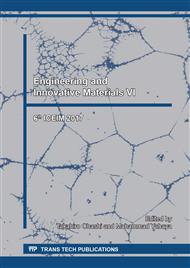p.246
p.254
p.261
p.267
p.275
p.280
p.286
p.292
p.297
Non-Isothermal Combustion Properties of Plant Biomaterial Using TG-DSC Technique
Abstract:
Nowadays, plant biomaterials have been used in several types of industries for related purposes for example energy and electricity production, as our world is facing energy shortage problems. In this paper, the combustion behavior of a typical plant biomaterial, corn cob, was investigated using TG-DSC technique. Combustion experiments were conducted from room temperature to 900 °C at three heating rates of 10, 20 and 30°C/min in air atmosphere. It is observed that the process can be divided into three stages: dehydration (25°C-150°C), pyrolysis (150°C-380°C) and combustion (above 380°C). Besides, ignition and burnout temperature were investigated based on DSC profiles. Finally, two model-free methods (FWO and KAS) were adopted to perform the kinetic analysis for combustion reaction process. It is found that activation energies values against conversion rate present a rising trend (from about 172.40 KJ/mol to 326.95 KJ/mol) in the pyrolysis stage, while an opposite tendency was observed in the combustion stage (from about 365.55 KJ/mol to 202.86 KJ/mol), indicating that corn cob combustion is a complex process and relatively complex reaction schemes should be adopted to describe its combustion. It is anticipated that our current work could be helpful in providing reference to the design of energy conversion facilitates.
Info:
Periodical:
Pages:
275-279
Citation:
Online since:
January 2018
Authors:
Keywords:
Price:
Сopyright:
© 2018 Trans Tech Publications Ltd. All Rights Reserved
Share:
Citation:


